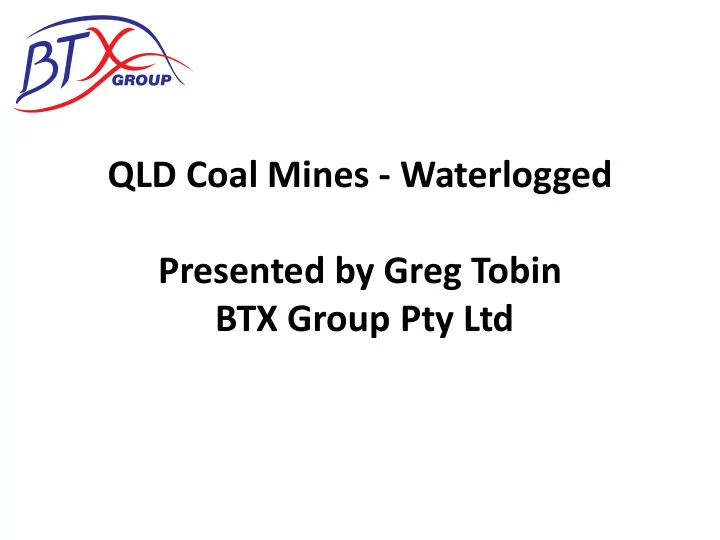

QLD Coal Mines - Waterlogged Presented by Greg Tobin BTX Group Pty Ltd
Contents • Introduction – What is the problem? • Water – What is in it? • Options – Where can we use it? • Treatment methods discussed • Cost Comparison • RO cost benefit analysis • Conclusion
INTRODUCTION • Problem - too much water stored on site. – 2010/2011 Floods; – DERM maintain strict release criteria; – Typically creeks need to be running for release – Total Dissolved Solids (TDS) above DERM guidelines It is estimated that QLD coal mines hold approximately 300 gigalitres of locked up water, the equivalent of half of Sydney Harbour (ref QRC). It has been suggested that the locked up water is holding up 25 million tonnes of coal production (Ref John McCarthy, Syd Telegraph)
Water - What is in it? • Ec or total dissolved solids • Leached from groundwater/coal • DERM water discharge guidelines – TDS <1000 mg/l (Ec 1500 microsiemens) – Turbidity <300 NTU, pH <8.8 – Sulphates, chlorides, cations, heavy metals limits • Why is it difficult to treat? – Solubility of Sulphates and Chlorides in the presence of Sodium, Potassium and other metals
Typical Pit Water Analysis Test Units Result pH pH unit 8.67 Electrical Conductivity microsiemens 9051 Total Alkalinity as CaCO3 mg/L 545 Sulphate mg/L 438 Chlorides mg/L 2810 Calcium mg/L 47 Magnesium mg/L 86 Sodium mg/L 1910 Cadmium mg/L <0.0001 Lead mg/L <0.001
Water use/reduction options • Irrigate • Road dust suppression • Evaporate • CHPP use • Precipitate impurities • Deionization/Softening • Reverse Osmosis
Treatment methods • Irrigate – High salts can damage top soil for farming/vegetation; – Real estate requirements;
DUST SUPPRESSION • ACARP report C14040 covers this area. • Need to consider impact of salts on road users.
Evaporation Evaporation rates in central Queensland are in the area of 2 metres annually. Depending on surface area in a dam, water loss is 5 to 10 % PA. Rates dependent on temperature humidity, wind speed. Now, pumps and evaporators are controlled by mini weather stations so they only operate when the temperature and wind direction is suitable. Rates are increased but depends on spray coverage and droplet size.
• CHPP use – High dissolved solids will increase corrosion and scale potential significantly – Can treat scaling or corrosion separately or together. – Typical Corrosion or Antiscalant treatment program cost $300,000 to $500,000 p.a. – Scale control - Acrylate, polyphosphates, PMA – Corrosion control – Zinc, polyphosphates, molybdates
Control Corrosive Waters
Corrosion Rate
Control Scaling Waters
Precipitation Softening • Reduces hardness, alkalinity, silica and other constituents • Treat with Lime, Soda Ash and Lime • Calcium Bicarbonate converts to Calcium Carbonate • Magnesium forms insoluble Magnesium Hydroxide • Permanent hardness more difficult to remove • Sodium Aluminate can reduce Magnesium and Silica • Soda Ash can reduce permanent Calcium hardness • Heavy metal removal
Sulphate Reduction • Many options available depending on level • Reverse osmosis • SPARRO – Slurry precipitation followed by RO • EDR- Electrodialysis Reversal • Precipitation of Gypsum with Lime addition • Biological Sulphate Reduction or Bioreactors • Depending on Sulphate level Bioreactors are very cost effective after Lime precipitation
Sulphate reduction plant costs for 1 meg/day plant • RO – Capex – $1.15M, Opex -$1.22/m3 • SPARRO - Capex – $1.2M, Opex -$0.42/m3 • EDR - Capex – $1.0M, Opex -$0.67/m3 – High maintenance, 99% removal • Lime - Capex – $.0325M, Opex -$.085/m3 – Low maintenance, 50% sulphate removal • Bioreactor - Capex – $0.45M, Opex -$0.425/m3 – Moderate maintenance, <90% removal
Reverse Osmosis Selectivity
Reverse Osmosis (cont’d) • Reverse Osmosis – Reduces the amount of dissolved solids in water; – Process that separates H 2 0 from salts; – Produce a permeate and brine; • RO Cost (produce 500kL/day of permeate) – New plant installation - $0.75M upfront & 25K/month to run – Hire RO plant installation - $150K upfront & 45K/month to run
RO Elements Removed Elements and the Percent R.O. Membranes will remove • Sodium 85 - 94% • Sulfate 96 - 98% • Calcium 94 - 98% • Potassium 85 - 95% • 60 – 75% Nitrate • 94 – 98% Iron • 95 – 98% Zinc • Mercury 95 – 98% • 94 – 96% Selenium • 96 – 98% Phosphate • 95 – 98% Lead • 92 – 96% Arsenic • 94 – 98% Magnesium • Nickel 96 – 98% • Fluoride 85 - 92% • 94 – 98% Manganese • 95 – 98% Cadmium • 95 – 98% Barium • 84 – 92% Cyanide • Chloride 85 – 92%
Typical RO setup at a mine Filtration Feed Tank 40m3 Pit Water Permeate Tank 30m3 Discharge off site or use to dilute other pit water (500kL per day) Waste Tank 30m3 Waste Drying Cell RO plant in a shipping container
Example of blending RO water with Pit Water
Deionization vs RO Deionization Reverse Osmosis • • Capex similar to RO Membrane filtration • • Removes all anions and cations RO purity continuous by resin beds • Lower Opex on chemicals • Purity progressively worse • Can remove SS, viruses • Ion exchange chemicals • Lower cost of operation expensive • Membrane life similar to beds • Uses Hydrochloric and Caustic • Membranes require cleaning • Requires hazardous disposal • Chemical addition required permit for resin • Pure water is 1 microsiemens • Regeneration waste to deal with
Conclusions • Need to work closely with DERM to get reasonable Environmental Agreement. • Method of treatment dependent on the water quality. • Each mine site is different and you need a detailed study initially. • With the water analysis presented RO would appear most suitable for approach. • Managing brine needs further consideration.
Acknowledgements • Many thanks to the Queensland Branch of the ACPS for inviting me to give this talk.
Recommend
More recommend